Reading is a great way to learn, grow, and broaden your perspective. Here are 30 book suggestions to read in your 30s:
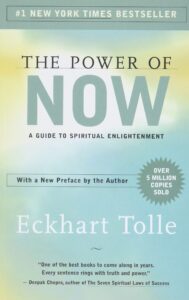
“The Power of Now” by Eckhart Tolle
“The Power of Now” is a spiritual guidebook written by Eckhart Tolle. The book is centered around the concept of living in the present moment and experiencing life fully without being weighed down by the past or future. The author argues that the key to happiness and fulfillment is to let go of mental attachments to the past and future and to focus on the present moment.
Tolle explains that the mind often creates a false sense of identity and attachment to thoughts and emotions that lead to suffering and anxiety. He suggests that by becoming aware of the present moment, we can detach ourselves from these negative patterns and experience a sense of inner peace and clarity.
The book includes practical exercises and meditations to help readers cultivate a deeper awareness of the present moment and connect with their inner selves. It has gained widespread popularity and has been translated into over 30 languages, inspiring readers around the world to embrace a more mindful and meaningful way of living.
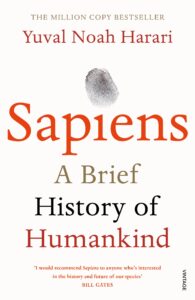
“Sapiens: A Brief History of Humankind” by Yuval Noah Harari
“Sapiens: A Brief History of Humankind” is a non-fiction book written by Yuval Noah Harari that explores the history of our species from the emergence of Homo sapiens in Africa to the present day. The book covers a wide range of topics, from the cognitive and agricultural revolutions to the rise of empires, capitalism, and globalization.
Harari argues that the success of Homo sapiens is largely due to our ability to create and believe in shared myths and stories, such as religion, nation-states, and money, which have enabled us to cooperate on a massive scale. He also explores the impact of technology on human society, including the development of writing, the printing press, and the internet.
Throughout the book, Harari challenges many commonly-held beliefs and assumptions about human history, and encourages readers to think critically about our place in the world and the direction of our future. “Sapiens” has been widely praised for its engaging writing style, thought-provoking ideas, and interdisciplinary approach to history and anthropology.

“The Alchemist” by Paulo Coelho
“The Alchemist” is a novel by Brazilian author Paulo Coelho. The book tells the story of Santiago, a young shepherd boy who dreams of finding treasure and embarks on a journey to Egypt to pursue his dream. Along the way, he meets a series of characters who help him understand the importance of following one’s dreams and listening to one’s heart.
Throughout the story, Santiago learns the value of perseverance, faith, and intuition. He discovers that the universe is always conspiring to help people achieve their dreams, as long as they are willing to take risks and overcome their fears.
“The Alchemist” is a timeless tale that has touched the hearts of millions of readers around the world. The book is known for its simple and inspiring message about the importance of following one’s dreams and pursuing one’s passions, regardless of the obstacles that may stand in the way. It has been translated into over 80 languages and has sold over 150 million copies worldwide.

“The 7 Habits of Highly Effective People” by Stephen Covey
“The 7 Habits of Highly Effective People” is a self-help book written by Stephen Covey. The book presents a holistic approach to personal and interpersonal effectiveness, based on principles of character and human nature.
Covey identifies seven habits that are essential for personal and professional success. The first three habits focus on personal development, and include being proactive, beginning with the end in mind, and putting first things first. The next three habits focus on interpersonal relationships, and include seeking first to understand, then to be understood, synergizing, and sharpening the saw. The final habit is about continuous improvement and renewal.
The book emphasizes the importance of aligning one’s values, goals, and actions, and encourages readers to take responsibility for their own lives and relationships. Covey’s approach is based on a belief in the fundamental principles of fairness, honesty, and human dignity, and he argues that these principles are essential for long-term success in any endeavor.
“The 7 Habits of Highly Effective People” has become a classic of the self-help genre, and has been translated into over 40 languages. The book has inspired millions of readers around the world to develop their personal and interpersonal effectiveness, and has been praised for its practical, common-sense approach to personal development.
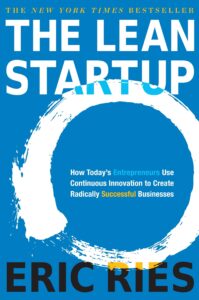
“The Lean Startup” by Eric Ries
“The Lean Startup” is a business book written by Eric Ries that presents a methodology for creating and running successful startups. The book is based on the principles of lean manufacturing and agile development, and emphasizes the importance of experimentation, customer feedback, and continuous improvement.
Ries argues that many startups fail because they follow traditional business planning and development models that do not account for the uncertainty and risk inherent in new ventures. Instead, he proposes a process of continuous innovation that focuses on building a minimum viable product (MVP), testing it with real customers, and iterating based on feedback.
The book emphasizes the importance of measuring progress using key performance indicators (KPIs) and making data-driven decisions based on customer feedback. It also addresses common challenges faced by startups, such as pivoting, scaling, and raising capital.
“The Lean Startup” has been widely praised for its practical advice and insights into the world of entrepreneurship. The book has become a bestseller and has been translated into over 30 languages, inspiring a new generation of startup founders and innovators around the world.
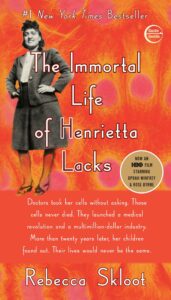
“The Immortal Life of Henrietta Lacks” by Rebecca Skloot
“The Immortal Life of Henrietta Lacks” is a non-fiction book written by Rebecca Skloot that tells the story of Henrietta Lacks, an African American woman whose cancer cells were taken without her knowledge in 1951 and became the first immortal human cell line. These cells, known as HeLa cells, have been used in scientific research for decades and have contributed to numerous medical breakthroughs.
The book not only tells the story of Henrietta Lacks and her contribution to science, but also explores the complex issues surrounding medical ethics, race, and class. Skloot delves into the history of medical experimentation on African Americans, and highlights the ongoing issues of informed consent, privacy, and ownership of biological material.
Throughout the book, Skloot weaves together the story of Henrietta Lacks and her family with the history of medical research and the scientific breakthroughs made possible by HeLa cells. She also examines the impact of these cells on scientific research and their importance in the development of vaccines, cancer treatments, and other medical advancements.
“The Immortal Life of Henrietta Lacks” has been widely praised for its engaging storytelling, meticulous research, and thought-provoking exploration of ethical issues in science and medicine. The book has been translated into over 25 languages and has received numerous awards, including the National Academies Communication Award and the Wellcome Trust Book Prize.
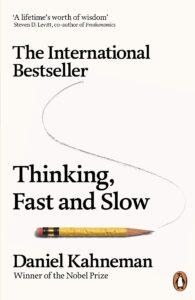
“Thinking, Fast and Slow” by Daniel Kahneman
“Thinking, Fast and Slow” is a book written by psychologist and economist Daniel Kahneman that explores the two systems of thinking that shape human judgment and decision-making.
The book argues that humans have two systems of thinking: System 1, which is intuitive, fast, and automatic, and System 2, which is more deliberative, slower, and requires effort. Kahneman presents numerous examples and experiments to illustrate how these two systems interact and influence our perceptions, judgments, and choices.
Kahneman also introduces the concept of cognitive biases, which are systematic errors in thinking that occur when we rely too heavily on intuition or incomplete information. He explores how cognitive biases can lead to errors in judgment and decision-making, and offers strategies for mitigating their effects.
The book covers a wide range of topics, from heuristics and biases to prospect theory and behavioral economics. It offers a comprehensive and accessible overview of the field of psychology and its implications for decision-making in everyday life.
“Thinking, Fast and Slow” has been widely praised for its insights into human cognition and decision-making, and has become a bestseller in numerous countries. The book has won several awards, including the National Academy of Sciences Communication Award and the Presidential Medal of Freedom.

“Quiet: The Power of Introverts in a World That Can’t Stop Talking” by Susan Cain
“Quiet: The Power of Introverts in a World That Can’t Stop Talking” is a book written by Susan Cain that explores the cultural bias towards extroversion and the value of introversion in modern society.
The book argues that introverts have unique strengths and perspectives that are often overlooked in a society that values extroverted traits such as gregariousness and assertiveness. Cain presents numerous examples and studies to illustrate how introverts have contributed to society and have often been the source of innovation and creativity.
Cain also examines the effects of our extrovert-biased culture on introverts, and how it can lead to feelings of shame, guilt, and social anxiety. She offers practical advice for introverts on how to navigate social situations and find ways to embrace their strengths and personality traits.
The book covers a wide range of topics, from the science of introversion and extroversion to the role of introverts in business, education, and leadership. It offers a thought-provoking and compelling argument for valuing introversion and the unique contributions of introverts in a world that often favors extroversion.
“Quiet” has been widely praised for its insightful analysis of introversion and its impact on society, and has become a bestseller in numerous countries. The book has been translated into over 40 languages and has received numerous awards, including the Books for a Better Life Award and the Goodreads Choice Award for Nonfiction.
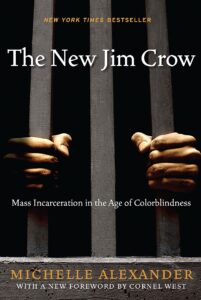
“The New Jim Crow” by Michelle Alexander
“The New Jim Crow: Mass Incarceration in the Age of Colorblindness” is a book written by Michelle Alexander that examines the racial bias and inequality in the criminal justice system in the United States.
The book argues that the war on drugs has been used as a tool to perpetuate racial discrimination and to maintain a system of social control over Black Americans. Alexander presents numerous examples and studies to illustrate how the criminal justice system has disproportionately impacted communities of color, leading to a cycle of poverty, social exclusion, and political disenfranchisement.
Alexander also examines the role of the media, politicians, and other powerful institutions in perpetuating racial stereotypes and biases, and how this has contributed to the stigmatization and marginalization of communities of color.
The book covers a wide range of topics, from the history of racial discrimination in the United States to the impact of mass incarceration on families and communities. It offers a comprehensive and compelling analysis of the criminal justice system and its impact on race relations in the United States.
“The New Jim Crow” has been widely praised for its insightful analysis of racial inequality and mass incarceration in the United States, and has become a bestseller in numerous countries. The book has received numerous awards, including the NAACP Image Award for Nonfiction and the Dayton Literary Peace Prize.
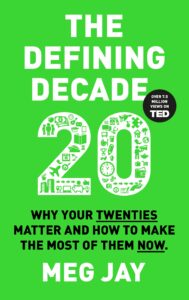
“The Defining Decade” by Meg Jay
“The Defining Decade: Why Your Twenties Matter–And How to Make the Most of Them Now” is a book written by clinical psychologist Meg Jay that explores the importance of the twenties in shaping one’s personal and professional life.
The book argues that the twenties are a critical decade in a person’s life, and that the choices made during this time can have a profound impact on future outcomes. Jay presents numerous examples and studies to illustrate how the decisions made in the twenties can shape one’s career trajectory, relationship patterns, and overall happiness and well-being.
Jay also examines the cultural and societal factors that can make the twenties a challenging time, including the pressure to succeed and the uncertainty that comes with navigating the transition to adulthood. She offers practical advice and strategies for making the most of this decade, including how to build a fulfilling career, develop healthy relationships, and cultivate a sense of purpose and identity.
The book covers a wide range of topics, from career development and relationship building to personal growth and mental health. It offers a thought-provoking and practical guide for young adults navigating the challenges and opportunities of their twenties.
“The Defining Decade” has been widely praised for its insightful analysis of the importance of the twenties in shaping one’s life trajectory, and has become a bestseller in numerous countries. The book has been translated into multiple languages and has received numerous awards, including the Books for a Better Life Award and the American Psychological Association’s Best Book Award.
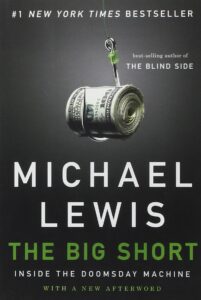
“The Big Short” by Michael Lewis
“The Big Short: Inside the Doomsday Machine” is a book written by Michael Lewis that explores the events leading up to the 2008 financial crisis and the people who predicted it.
The book tells the story of a small group of investors who recognized the impending collapse of the housing market and bet against the financial institutions that were fueling the subprime mortgage boom. Lewis follows the journeys of these investors and their interactions with the financial industry, providing insight into the complexities of the financial system and the flaws that led to the crisis.
“The Big Short” also examines the broader social and economic implications of the crisis, including the impact on individuals and communities who were most affected by the collapse of the housing market.
The book covers a wide range of topics, from the history of the financial industry to the role of regulators and politicians in shaping the financial system. It offers a detailed and compelling account of the events leading up to the crisis, and the people who saw it coming.
“The Big Short” has been widely praised for its insightful analysis of the financial crisis and its impact on society, and has become a bestseller in numerous countries. The book has been adapted into a feature film, which was released in 2015 and was nominated for several Academy Awards.
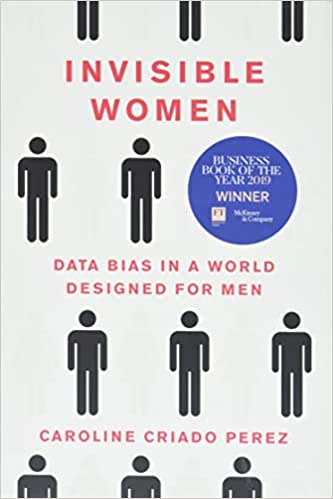
“Invisible Women: Data Bias in a World Designed for Men” by Caroline Criado Perez
“Invisible Women: Data Bias in a World Designed for Men” is a book written by Caroline Criado Perez that explores the pervasive gender bias in data and the resulting impact on women’s lives.
The book argues that the world is designed with men in mind, and that women are often overlooked in the design of everything from office temperatures to transportation systems. Perez presents numerous examples and studies to illustrate how the lack of data on women’s experiences and needs has resulted in a world that is often unsafe, uncomfortable, and inefficient for women.
Perez also examines the role of data and research in shaping policies and decisions that affect women’s lives, and how the lack of gender-disaggregated data has resulted in policies that are not only ineffective but can also be harmful to women.
The book covers a wide range of topics, from workplace discrimination and healthcare disparities to the gender gap in technology and the built environment. It offers a compelling and eye-opening analysis of the ways in which gender bias pervades society, and the urgent need to address this bias through better data and research.
“Invisible Women” has been widely praised for its insightful analysis of gender bias and its impact on society, and has become a bestseller in numerous countries. The book has received numerous awards, including the Royal Society Insight Investment Science Book Prize and the Financial Times and McKinsey Business Book of the Year Award.
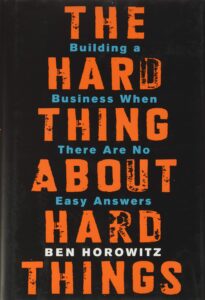
“The Hard Thing About Hard Things” by Ben Horowitz
“The Hard Thing About Hard Things: Building a Business When There Are No Easy Answers” is a book written by Ben Horowitz, a successful entrepreneur and venture capitalist, that explores the challenges of building and managing a startup.
The book offers practical advice and insights on the difficulties of running a business, including managing employees, raising capital, dealing with competition, and making tough decisions. Horowitz draws on his own experiences as the co-founder and CEO of multiple startups to provide candid and relatable examples of the challenges faced by entrepreneurs.
In addition to practical advice, the book also delves into the emotional toll of building and managing a startup, including dealing with failure and navigating personal relationships while balancing the demands of a high-growth business.
“The Hard Thing About Hard Things” has been widely praised for its honest and relatable approach to entrepreneurship, and has become a bestseller in numerous countries. The book has been recommended by notable entrepreneurs and business leaders, and has been praised for its practical and actionable advice for anyone starting or managing a business.

“The Gift of Fear” by Gavin de Becker
“The Gift of Fear: Survival Signals That Protect Us from Violence” is a book written by Gavin de Becker that explores the role of fear as a protective mechanism against violence and how to recognize and trust our instincts to stay safe.
De Becker draws on his years of experience as a security expert and threat assessment specialist to provide insights and examples of how fear can be a powerful tool in protecting ourselves from potential danger. He explains that our intuition and instinctive responses to perceived threats are often more reliable than rational analysis, and offers practical advice on how to recognize and respond to danger signals.
The book covers a wide range of topics related to personal safety, including the warning signs of stalking and domestic violence, the psychology of perpetrators, and the importance of setting boundaries and trusting our instincts.
“The Gift of Fear” has been widely praised for its practical and empowering approach to personal safety, and has become a bestseller in numerous countries. The book has been recommended by law enforcement officials, victims’ advocates, and survivors of violence, and has been praised for its compassionate and empowering message of self-protection.
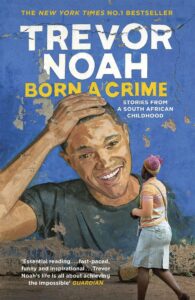
“Born a Crime” by Trevor Noah
“Born a Crime: Stories from a South African Childhood” is a memoir by Trevor Noah, the host of “The Daily Show” and a comedian, that explores his experiences growing up in South Africa during and after apartheid.
Noah was born to a white father and a black mother, a union that was illegal under apartheid. As a result, he was classified as “colored” and faced discrimination and marginalization from both black and white communities. The book details his childhood experiences, including his mother’s struggles to raise him as a single parent, his experiences with racism and violence, and his eventual rise to fame as a comedian.
In addition to providing a personal perspective on South Africa’s history and culture, “Born a Crime” also delves into themes of identity, family, and the power of storytelling. Noah’s humor and wit are present throughout the book, even as he tackles difficult and often traumatic subjects.
The book has been widely praised for its honesty, humor, and insight into South African history and culture. It has become a bestseller in numerous countries, and has won several awards, including the James Thurber Prize for American Humor and the Audie Award for Best Autobiography/Memoir.

“The Road” by Cormac McCarthy
“The Road” is a novel by Cormac McCarthy that tells the story of a father and his young son as they journey through a post-apocalyptic world, struggling to survive in a harsh and unforgiving environment.
The book explores themes of love, survival, and hope in the face of overwhelming despair. The father and son are unnamed characters, and their relationship is central to the story. The father is determined to protect his son and ensure his survival, even as they face starvation, violence, and other dangers on their journey.
McCarthy’s spare and poetic prose captures the bleakness of the post-apocalyptic world, while also highlighting the enduring human spirit that allows the father and son to keep going despite the odds.
“The Road” has been widely praised for its powerful and evocative writing, and has become a bestseller in numerous countries. It won the Pulitzer Prize for Fiction in 2007, and has been adapted into a film starring Viggo Mortensen as the father.

“The Checklist Manifesto” by Atul Gawande
“The Checklist Manifesto: How to Get Things Right” is a book by Atul Gawande that explores the importance of checklists in improving efficiency, reducing errors, and increasing safety in various industries.
Gawande, a surgeon and writer, draws on his experiences in medicine, aviation, and construction to make the case for the use of checklists as a tool for managing complexity and improving performance. He argues that in complex systems, even highly skilled professionals can make mistakes or overlook important details, and that checklists can help prevent errors and improve outcomes.
The book provides numerous examples of how checklists have been used effectively in a variety of industries, from surgery to aviation to investment banking. Gawande also explores the psychology of checklists, discussing how they can help people focus, communicate more effectively, and make better decisions.
“The Checklist Manifesto” has been widely praised for its clear and engaging writing, and for its practical insights into how checklists can be used to improve performance in a variety of fields. It has become a bestseller in numerous countries, and has been recommended by professionals in fields as diverse as medicine, finance, and education

“The Happiness Project” by Gretchen Rubin
“The Happiness Project” is a self-help book by Gretchen Rubin that chronicles her year-long journey to become happier and more fulfilled in her daily life. Rubin, a lawyer turned writer, explores the science of happiness and the practical strategies she used to improve her own happiness and well-being.
The book is divided into twelve chapters, each focusing on a different theme or aspect of happiness, such as gratitude, relationships, and work. Rubin sets specific goals for herself within each chapter, and shares her experiences and insights along the way.
Rubin’s approach to happiness is practical and rooted in science, drawing on the work of positive psychologists and other researchers. She emphasizes the importance of small, incremental changes in daily habits and routines, rather than big, dramatic overhauls.
“The Happiness Project” has been widely praised for its relatable and accessible approach to self-improvement. It has become a bestseller in numerous countries, and has inspired many readers to embark on their own happiness projects. Rubin has since written several other books on happiness and habits, and has become a leading voice in the field of self-help and personal development.
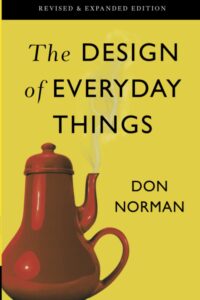
“The Design of Everyday Things” by Don Norman
“The Design of Everyday Things” is a book by Don Norman that explores the principles of good design and how they can be applied to everyday objects and systems. Norman, a cognitive scientist and designer, argues that good design is essential for creating products that are both functional and easy to use.
The book covers a range of topics related to design, including affordances (the perceived or actual properties of an object that suggest how it can be used), feedback (the information a user receives about the results of their actions), and mapping (the relationship between controls and their effects). Norman also discusses the importance of user-centered design, and provides numerous examples of good and bad design in everyday products and systems.
“The Design of Everyday Things” has become a classic in the field of design, and has been widely praised for its insights into the psychology of human behavior and the principles of good design. It has influenced many designers and engineers, and has helped to popularize the concept of user-centered design. Norman has since written several other books on design and technology, and has become a leading voice in the field of human-centered design.

“The Tao of Pooh” by Benjamin Hoff
“The Tao of Pooh” is a book written by Benjamin Hoff, published in 1982. It is a unique book that presents the principles of Taoism through the characters and stories of A.A. Milne’s Winnie-the-Pooh.
The book uses Winnie-the-Pooh, a simple-minded, honey-loving bear, as an example of a person who embodies the principles of Taoism. Hoff argues that the other characters in the book, such as Piglet, Rabbit, and Tigger, represent various philosophical positions, and that Winnie-the-Pooh’s simplicity and lack of ambition allow him to embody the Taoist ideal of simplicity and harmony with nature.
Through his interactions with the other characters, Hoff shows how Pooh’s Taoist approach to life allows him to solve problems and find happiness without striving or struggling. The book is written in a humorous, accessible style, making it an enjoyable read for people of all ages.
Overall, “The Tao of Pooh” is a clever and insightful book that presents the principles of Taoism in an entertaining and accessible way. It is a great introduction to Taoism for anyone interested in philosophy or spirituality, and it is also a fun read for fans of Winnie-the-Pooh.
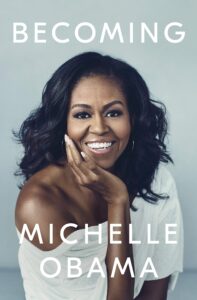
“Becoming” by Michelle Obama
“Becoming” is a memoir by Michelle Obama, the former First Lady of the United States. The book chronicles Obama’s life, from her childhood in Chicago to her years in the White House, and explores the challenges and triumphs she faced along the way.
The book is divided into three parts, each focusing on a different stage of Obama’s life. Part One covers her childhood and education, including her experiences as a young black woman in a predominantly white school. Part Two covers her career, marriage to Barack Obama, and experiences as First Lady. Part Three covers her life after leaving the White House, including her ongoing activism and advocacy work.
Throughout the book, Obama reflects on the importance of family, community, and education in shaping her life, and shares personal anecdotes and insights into her experiences as a public figure. She also discusses some of the controversies and criticisms she faced during her time in the White House, and offers her perspective on issues such as race, gender, and politics.
“Becoming” has been widely praised for its honesty, warmth, and insightful commentary on contemporary issues. The book became an instant bestseller upon its release, and has been translated into numerous languages. Obama has since become a leading voice in the fields of activism, education, and women’s empowerment, and continues to inspire people around the world with her story.

“Grit: The Power of Passion and Perseverance” by Angela Duckworth
“Grit: The Power of Passion and Perseverance” is a book by psychologist Angela Duckworth that explores the importance of resilience, hard work, and perseverance in achieving success. Duckworth argues that talent alone is not enough to achieve greatness, and that a combination of passion and perseverance, or “grit,” is essential for reaching one’s goals.
The book is divided into three parts. Part One focuses on the nature of grit, and explores how it is developed and sustained over time. Part Two examines the role of effort in achieving success, and argues that deliberate practice is essential for improving one’s skills and abilities. Part Three explores the importance of purpose and meaning in life, and how having a clear sense of direction can help individuals overcome challenges and setbacks.
Throughout the book, Duckworth draws on a range of research and real-world examples to illustrate her points, including interviews with successful athletes, artists, and entrepreneurs. She also provides practical advice for developing grit, such as setting specific goals, developing a growth mindset, and cultivating resilience in the face of failure.
“Grit: The Power of Passion and Perseverance” has been widely praised for its insights into the psychology of achievement, and for its practical advice for individuals seeking to improve their own resilience and perseverance. The book has become a bestseller, and has been translated into numerous languages. Duckworth has since become a leading expert in the field of grit and resilience, and continues to conduct research and write about the topic.

“The Miracle Morning” by Hal Elrod
“The Miracle Morning” is a self-help book by Hal Elrod that outlines a morning routine designed to improve one’s productivity, health, and overall well-being. The book argues that starting the day with a set of positive habits and rituals can help individuals achieve their goals and transform their lives.
The book is divided into two parts. Part One outlines the core concepts of the Miracle Morning routine, which involves waking up early and spending time on six specific activities: silence, affirmations, visualization, exercise, reading, and writing. Elrod explains how each of these activities can contribute to improved physical and mental health, increased productivity, and a more positive outlook on life.
Part Two provides practical guidance on how to implement the Miracle Morning routine, including tips on setting goals, overcoming obstacles, and developing a consistent habit. The book also includes case studies and testimonials from individuals who have successfully incorporated the Miracle Morning into their daily lives.
“The Miracle Morning” has become a bestseller, and has spawned a popular movement of individuals who practice the routine on a daily basis. The book has been praised for its practical advice and accessible writing style, and for its emphasis on the power of positive habits and routines in achieving personal success. Elrod has since become a leading voice in the field of personal development, and continues to write and speak on the topics of productivity and well-being.

“Man’s Search for Meaning” by Viktor Frankl
“Man’s Search for Meaning” is a book by Austrian neurologist and psychiatrist Viktor Frankl, based on his experiences as a prisoner in Nazi concentration camps during World War II. The book is divided into two parts, the first of which describes Frankl’s experiences in the camps, including the dehumanizing conditions, the struggle for survival, and the horrors of the Nazi regime.
The second part of the book outlines Frankl’s philosophical and psychological approach to life, which he called logotherapy. Frankl argues that the search for meaning and purpose in life is the primary motivation of human beings, and that even in the most extreme circumstances, individuals can find meaning and fulfillment through their experiences and relationships.
The book has become a classic in the field of psychology and personal development, and has been translated into numerous languages. It has been praised for its insights into the human condition, and for its emphasis on the importance of finding meaning and purpose in life, even in the face of extreme adversity. Frankl’s approach to psychology and personal development has had a profound influence on subsequent generations of psychologists, and his ideas continue to be studied and applied in a variety of fields.

“Eating Animals” by Jonathan Safran Foer
“Eating Animals” is a nonfiction book by American author Jonathan Safran Foer, published in 2009. The book explores the ethics and environmental impact of factory farming and the consumption of meat in modern society.
The book is structured as a combination of personal narrative, investigative journalism, and philosophical reflection. Foer draws on his own experiences as a meat-eater, as well as interviews with farmers, scientists, and activists, to explore the complex issues surrounding animal agriculture.
Foer argues that factory farming is not only cruel to animals, but also harmful to human health and the environment. He suggests that our society’s casual acceptance of meat consumption is based on a range of cultural and psychological factors, and that we need to re-evaluate our relationship with animals and the natural world.
The book has been praised for its thoughtful and thought-provoking analysis of the meat industry, and for its accessible and engaging writing style. It has also been criticized by some for its one-sidedness and for its failure to engage with the perspectives of those who support animal agriculture.
Despite these criticisms, “Eating Animals” has had a significant impact on public discourse around animal rights, environmentalism, and the ethics of food production. It has inspired many readers to reconsider their own consumption habits, and has contributed to the growing movement toward plant-based diets and sustainable agriculture.

“Zero to One” by Peter Thiel
“Zero to One” is a nonfiction book by American entrepreneur and investor Peter Thiel, published in 2014. The book presents Thiel’s philosophy on building successful startups and creating innovative businesses.
The title “Zero to One” refers to the concept of creating something entirely new, as opposed to merely copying what already exists. Thiel argues that the most successful companies are those that create something new, rather than simply improving on existing products or services.
Throughout the book, Thiel discusses a range of topics related to startup success, including the importance of focus, the role of technology in business, and the value of creating a strong team culture. He also emphasizes the need for entrepreneurs to think strategically about their businesses and to take calculated risks in order to achieve success.
The book has been praised for its clear and practical advice on startup strategy, as well as for its insights into the mindset of successful entrepreneurs. However, it has also been criticized by some for its controversial views on topics such as monopolies and the role of government in business.
Despite these criticisms, “Zero to One” has become a popular resource for entrepreneurs and investors seeking to build successful startups. Its emphasis on the importance of innovation and strategic thinking has resonated with many readers, and it has been translated into multiple languages and widely read around the world.

“Daring Greatly” by Brene Brown
“Daring Greatly” is a self-help book by Brené Brown, a research professor at the University of Houston Graduate College of Social Work. The book was published in 2012 and explores the power of vulnerability and the importance of embracing it in order to live a wholehearted life.
The title of the book comes from a quote by Theodore Roosevelt, in which he talks about the importance of showing up and being willing to take risks, even if it means failing or experiencing disappointment. Brown expands on this idea, arguing that vulnerability is not a weakness, but a strength, and that it is essential for building deep and meaningful connections with others.
Throughout the book, Brown shares insights from her research on shame and vulnerability, as well as personal stories and anecdotes from her own life. She discusses the ways in which vulnerability can be uncomfortable and scary, but also how it can lead to greater creativity, innovation, and personal growth.
Brown also explores the ways in which shame can hold us back from embracing vulnerability and living wholeheartedly, and offers strategies for overcoming shame and building resilience.
“Daring Greatly” has been praised for its powerful message and practical advice on how to live a more authentic and fulfilling life. It has become a popular resource for individuals seeking to build deeper connections with others, overcome feelings of shame and inadequacy, and embrace vulnerability as a strength.
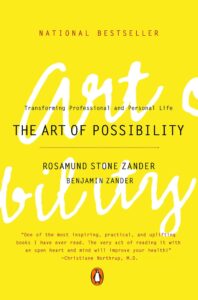
“The Art of Possibility” by Rosamund Stone Zander and Benjamin Zander
“The Art of Possibility” is a self-help book written by Rosamund Stone Zander and Benjamin Zander, a couple who are experts in the fields of personal growth and leadership development. The book was first published in 2000 and has since become a bestseller, inspiring readers to live more creative and fulfilling lives.
The book presents a series of twelve practices, or “rules of possibility,” designed to help readers shift their mindset from one of limitation and scarcity to one of abundance and possibility. The authors draw on their own experiences as coaches and musicians to illustrate these practices, offering anecdotes and stories that help readers understand the concepts in a practical and accessible way.
The book is divided into three sections. The first section, “It’s All Invented,” challenges readers to examine their assumptions and beliefs about the world and themselves, and to consider new possibilities. The second section, “Stepping into a Universe of Possibility,” explores the ways in which individuals can cultivate a mindset of abundance and possibility, and create new opportunities for themselves and others. The third section, “Giving an A,” encourages readers to approach life with a sense of possibility and to recognize the potential in themselves and others.
The book has been praised for its inspiring and practical message, as well as its engaging and accessible writing style. It has become a popular resource for individuals seeking to develop their leadership skills, enhance their creativity, and live more fulfilling and meaningful lives.
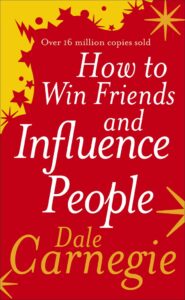
“How to Win Friends and Influence People” by Dale Carnegie
“How to Win Friends and Influence People” is a self-help book written by Dale Carnegie. It was first published in 1936 and has since sold millions of copies worldwide, making it one of the best-selling books of all time. The book offers practical advice on how to improve one’s social and professional skills, and is often considered a classic in the field of personal development.
The book is divided into four sections, each of which focuses on a different aspect of interpersonal communication and relationship building. The first section, “Fundamental Techniques in Handling People,” offers tips on how to interact with others in a positive and constructive way, such as avoiding criticism and showing appreciation. The second section, “Six Ways to Make People Like You,” provides advice on how to build rapport with others and cultivate positive relationships. The third section, “How to Win People to Your Way of Thinking,” offers strategies for persuading others and getting them to see things from your perspective. The fourth and final section, “Be a Leader: How to Change People Without Giving Offense or Arousing Resentment,” offers guidance on how to lead others effectively and inspire them to take action.
The book is based on Carnegie’s extensive experience as a teacher and lecturer, and is full of real-life examples and anecdotes that illustrate his points. It has been praised for its practical and straightforward advice, as well as its emphasis on empathy and understanding. The book has been influential in the fields of business, leadership, and personal development, and continues to be widely read and recommended today.
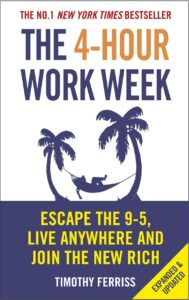
“The 4-Hour Work Week” by Timothy Ferriss
“The 4-Hour Work Week” is a self-help book written by Timothy Ferriss. It was first published in 2007 and quickly became a bestseller, popularizing the concept of lifestyle design and digital nomadism. The book offers advice on how to increase productivity, create passive income streams, and live a more fulfilling life by working smarter instead of harder.
The book is divided into four sections, each of which focuses on a different aspect of lifestyle design. The first section, “Definition,” challenges readers to question the traditional notion of work and success, and to think creatively about how to live a fulfilling life. The second section, “Elimination,” offers strategies for streamlining and automating one’s work and personal life, in order to create more time and freedom. The third section, “Automation,” explores the concept of outsourcing and delegation, and offers advice on how to build a team of virtual assistants to handle routine tasks. The fourth and final section, “Liberation,” offers tips on how to travel the world, explore new opportunities, and live life on one’s own terms.
The book is based on Ferriss’s personal experience as an entrepreneur and investor, and is full of practical advice, case studies, and resources. It has been praised for its unconventional approach to work and life, as well as its emphasis on personal empowerment and freedom. The book has been influential in the fields of entrepreneurship, digital nomadism, and lifestyle design, and continues to be a popular resource for those seeking to live a more unconventional and fulfilling life.
This is just a small selection of books to read in your 30s, and there are many other great books out there that may suit your interests and needs. As always, it’s important to read widely and diversely to expand your knowledge and understanding of the world.








